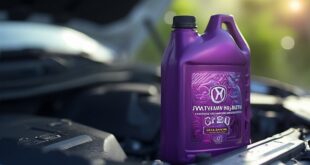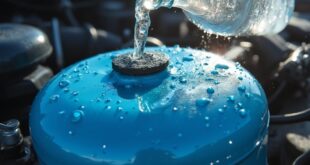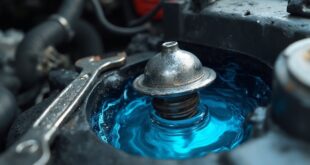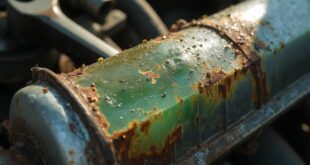A defective radiator cap can showcase several signs of cooling system failure. Coolant pooling under the vehicle suggests leaks, while dried white streaks on the radiator surface indicate evaporated coolant. Consistently low coolant levels hint at ongoing issues. An overflowing reservoir points to excessive pressure, and an overheating engine is often linked to cap malfunction. Regular inspections of these symptoms can prevent serious engine damage. Discover more about the essential functions of the radiator cap for peak performance.
Coolant Pooling Under the Vehicle
When coolant pools under a vehicle, it often signals a significant issue within the cooling system. This pooling indicates that the sealed system is unable to retain coolant, pointing to potential leaks.
A defective radiator cap may be a primary culprit, as it can fail to maintain the proper pressure and seal, allowing coolant to escape. If left unaddressed, such leaks can lead to engine overheating, causing severe damage over time.
Consequently, it is essential to investigate the source of the leak immediately. Regular inspections can help prevent coolant loss and guarantee the system operates effectively.
Dried White Streaks on the Radiator Surface
Dried white streaks on the radiator surface serve as a visual warning of potential coolant issues.
These streaks typically indicate that coolant has evaporated before reaching the ground, suggesting a possible leak in the radiator cap. When coolant burns off, it leaves behind mineral deposits that manifest as white residue.
This condition may not seem severe initially; however, it can point to an internal leak that, if left unaddressed, could lead to significant engine problems.
Regular inspections of the radiator can help identify these early signs, ensuring timely maintenance and preventing further complications in the cooling system.
Consistently Low Coolant Levels
Consistently low coolant levels can indicate a serious issue with the vehicle's cooling system.
When a vehicle's sealed system fails to maintain proper coolant levels, it may signify a malfunctioning radiator cap.
Frequent need for coolant replenishment often points to potential leaks or internal failures.
This loss of coolant can lead to severe overheating and engine damage if left unaddressed.
Regular monitoring is vital for maintaining engine health, and an investigation into the cause of low levels is necessary.
Identifying radiator cap issues early can prevent costly repairs and guarantee the vehicle operates efficiently.
Overflowing Reservoir
An overflowing reservoir is a clear indication of potential issues within the vehicle's cooling system. This phenomenon often occurs due to excess pressure generated by coolant, which may result from a faulty radiator cap.
When the cap fails to regulate pressure appropriately, it can lead to excessive fluid being redirected back to the reservoir. Over time, this overflow can cause damage to engine components and result in coolant loss.
Regular inspections of the cooling system and the radiator cap are essential to identify and address these issues before they escalate into more serious problems.
Overheating Engine
When a vehicle's engine begins to overheat, it can often be traced back to a malfunctioning radiator cap. This critical component regulates the cooling system's pressure, and its failure can lead to severe engine damage. Signs of overheating include steam, warning lights, and strange noises.
| Symptoms | Consequences |
|---|---|
| Steam from the engine | Engine damage can occur |
| Warning lights | Risk of complete failure |
| Unusual noises | Expensive repairs needed |
| Frequent coolant loss | Potential breakdown |
Addressing overheating issues promptly can save both time and money, emphasizing the importance of a functional radiator cap.
Functions of the Radiator Cap
A malfunctioning radiator cap can considerably disrupt the cooling system's operations, leading to potential engine overheating.
The radiator cap serves several critical functions. It pressurizes the cooling system, raising the boiling point of the coolant, which enhances engine efficiency. In addition, it relieves excess pressure to prevent damage to the system.
By sealing the cooling system, the cap prevents air intrusion, which can lead to overheating. Moreover, it directs coolant back to the radiator through a vacuum valve, ensuring ideal engine temperature.
Consequently, maintaining a properly functioning radiator cap is essential for preventing costly engine damage.
Frequently Asked Questions
How Often Should I Check My Radiator Cap for Wear?
Regular checks of the radiator cap should occur every few months or during routine maintenance. Observing coolant levels and visual inspections can help identify potential wear, ensuring the engine remains adequately protected from overheating and other issues.
Can a Bad Radiator Cap Affect My Vehicle's Fuel Efficiency?
A malfunctioning radiator cap can indirectly affect fuel efficiency. If the engine overheats due to improper pressure regulation, it may lead to reduced performance and increased fuel consumption, ultimately compromising overall vehicle efficiency.
What Tools Do I Need to Replace the Radiator Cap?
To replace a radiator cap, one needs a new cap, safety gloves, a towel for spills, and possibly a funnel for coolant. Ensuring the engine is cool is also essential for safe replacement.
Is It Safe to Drive With a Defective Radiator Cap?
Driving with a defective radiator cap is unsafe. It can lead to coolant leaks, overheating, and potential engine damage. Regular monitoring is advisable to guarantee the cooling system functions properly and to avoid costly repairs.
How Can I Identify the Right Radiator Cap for My Vehicle?
To identify the appropriate radiator cap, one must consult the vehicle's owner manual or specifications. Additionally, checking the existing cap's model number and size guarantees compatibility for ideal performance and safety in the cooling system.
 Car Service Land Coupons for Oil change, Tires, Wheel alignment, Brakes, Maintenance
Car Service Land Coupons for Oil change, Tires, Wheel alignment, Brakes, Maintenance




